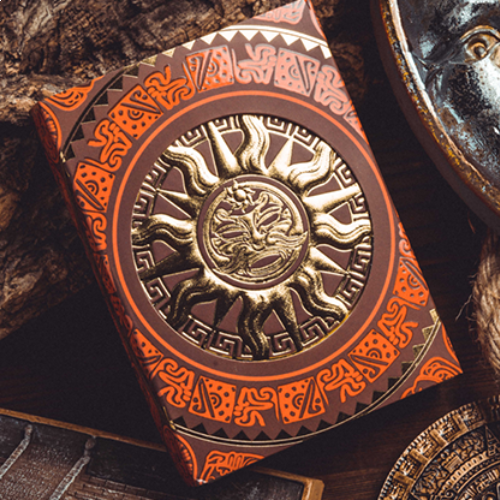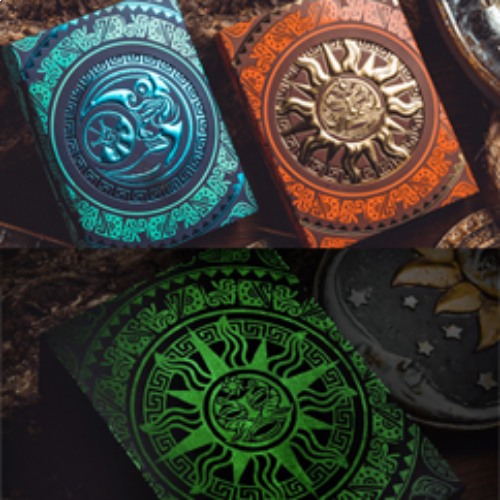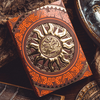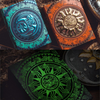MAYA SUN PLAYING CARDS
Features :
- 3D leaf and embossing on the case
- Each facial card presents the original illustration of a Mayan god goddess
- Pantone Premium metallic ink on the back
- Printed by Bacon Playing Card Company (BPCC) in China
Maya mythology encompasses all Mayan tales in which the deities, the personified forces of nature and the heroes who interact with them play a major role. The Mayans believed that the origins of most natural and cultural phenomena were stated, often with the moral aim of defining the ritual relationship between humanity and its environment.
The scholars stressed that in Mayan mythology, the gods and the goddesses had different names and demonstrations; The stories occurred in various forms; The scenes and the characters moved with disconcerting suddenness. However, under these apparent inconsistencies was the shared belief that the universe was an ordered place and that the appropriate behaviors towards the gods were crucial to maintain its balance and its harmony.
Inspired by Maya mythology, the game is available in two variants differentiated by colors, called "The Sun Deck" and "The Moon Deck".
The Mayans were ardent astronomers. They believed that the celestial bodies were gods and interpreted their movements as gods traveling between earth, the underground world and other celestial destinations. Given that these gods were strongly involved in human affairs (to the point that many events were planned according to certain celestial moments; the dynasties often claimed to be descended from the sun or the moon), the Mayans studied intensively every aspect of the sky , especially the sun and the moon.
The jokers use visuals similar to those of the cases but on faded funds:
The AS of Pique is distinguished by the illustration of Chichen Itza, a large pre -Columbian city built by the Mayans of the terminal period Classic.
Chichen Itza, one of the largest Mayan cities built, remains today one of the most visited archaeological sites in Mexico.
As for the back design, the symbol in the center is known as Hunab Ku (or the galactic butterfly). Often represented as a spiral galaxy in black and white, it looks like the Yin-Yang symbol of Asia. Likewise, it represents the harmonious fusion of opposites, the duality in all things and the one and only God. Serving as a bridge that connects good and evil, men and women, life and death, consciousness and unconsciousness, etc., the Hunab Ku is a symbol of order, balance, fullness, of energy unit and conservation in the universe.
The rings -shaped patterns are made up of Maya glyphs (made artistically). They represented words or syllables that could be combined to train any word or concept in the Mayan language.
The case is protected and decorated by an packaging pocket with hollowed out design.
"The Pantheon of the Mayans is a vast collection of venerated deities in the regions of Yucatan, Quintana Roo, Campeche, Tabasco and Chiapas in Mexico and south through Guatemala, Belize, El Salvador and Honduras. These gods informed the Life and the rituals of the people, established order and gave hope for a life after death. "
- Joshua J. Mark, "The Maya Pantheon: the many gods of the Mayans", encyclopedia of world history.
About the Maya Moon game:
The moon was one of the most enigmatic and most important elements of Mayan mythology, which often associated it with a young girl, an old woman or a rabbit.
The Mayan goddess of the Moon is Ixchel, the patron of fertility and the creation of life.
The Mayans were aware of the influence of the moon on the tidal waves, harvests and fertility, they therefore devoted themselves to the identification and recording of its phases.
About the Maya Sun game:
The sun was of the utmost importance for the Mayans.
The Solar God Maya, Kinich Ahau, is one of the most powerful gods of the Maya Pantheon. He shines in the sky all day before turning into Jaguar at night to wander in the Maya underground world.
Mayans were experts to predict solar phenomena such as eclipses, solstices and equinoxes.
Solar cycles have formed the base of the Mayan calendar.

 English
English


























